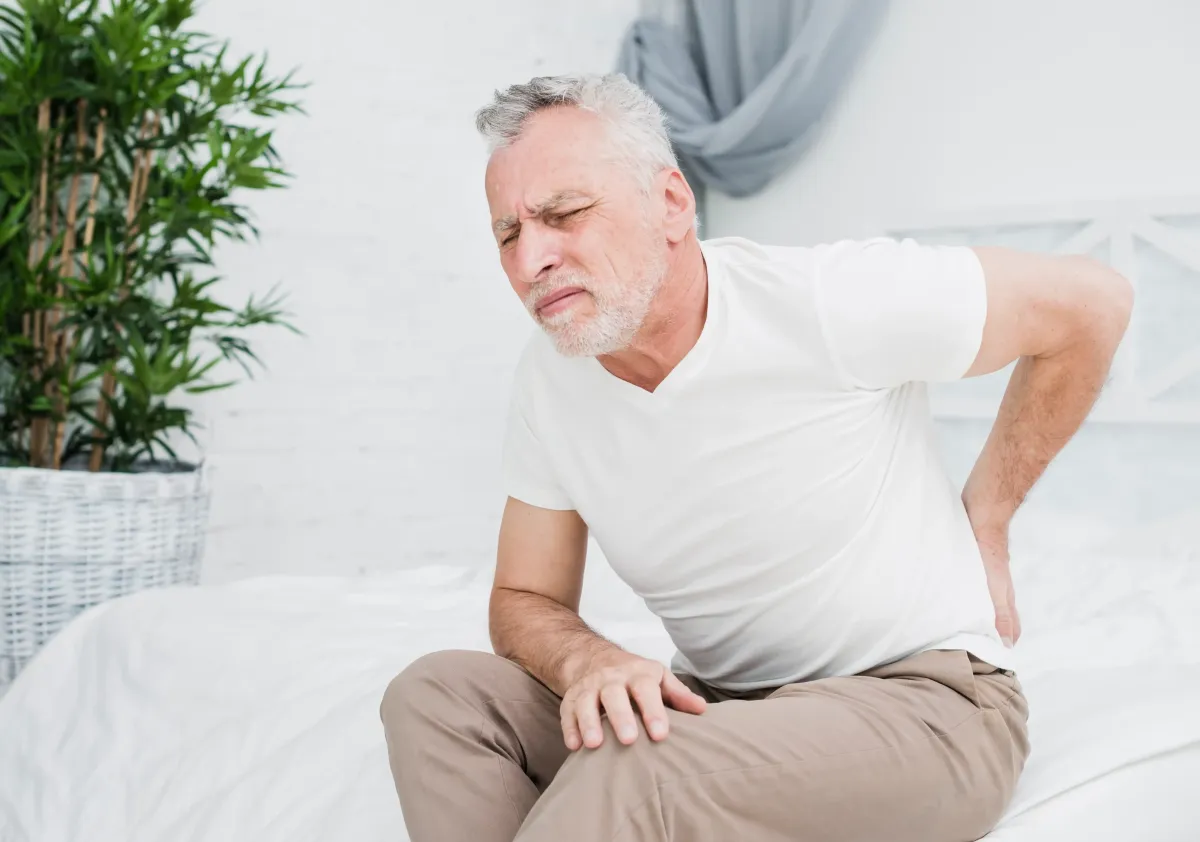Hip Pain Physical Therapy in Clifton, NJ
Clifton Physical Therapy

What Is Hip Pain?
Hip pain is discomfort in or around the hip joint, the area where your thigh bone meets your pelvis. This joint is one of the largest in the body and plays a key role in supporting your weight, keeping your balance, and helping you move every day. Hip pain can feel different depending on what part of the joint is affected. Sometimes it is close to the surface, which usually points to issues with muscles, tendons, or ligaments. Other times, the pain comes from deeper inside the joint, indicating problems with bones or cartilage. It is also common for pain to radiate to the lower back or groin.
The intensity of hip pain can vary. Some people notice it only when walking, climbing stairs, or lying on the affected side at night, while others may feel stiffness in the morning or soreness that gradually worsens throughout the day.
Why Does Hip Pain Happen?
Hip pain is usually a symptom of an underlying condition rather than a problem on its own. One common cause is arthritis, such as osteoarthritis, which gradually wears down the joint and leads to stiffness, swelling, and discomfort. Bursitis is another frequent source of hip pain, where the small fluid-filled sacs called bursae that cushion the joint become inflamed. Trochanteric bursitis, in particular, often causes pain on the outside of the hip.
Injuries can also lead to hip pain. Muscle strains, labral tears, fractures, and dislocations can all affect the joint and surrounding tissues. Sports injuries or falls are common triggers, and repetitive movements over time can strain the hip as well. Some people are born with structural differences in the hip, like hip impingement or developmental dysplasia, which can increase the likelihood of pain. Muscle weakness or imbalance, especially in the glutes or hip flexors, may also contribute to discomfort. Identifying the cause is essential to choosing the most effective treatment.
Where Do You Feel Hip Pain and What Does It Mean?
The location of hip pain often gives clues about what is causing it. Pain on the outside of the hip usually points to problems with muscles, tendons, or bursae. Discomfort in the front of the hip or the groin area often indicates joint issues, labral tears, or hip impingement. Pain in the back of the hip or the buttocks can sometimes be related to the sacroiliac joint or other supporting structures.
Noticing when the pain occurs and what triggers it can also be helpful. Pain that worsens with walking, stair climbing, or lying on the affected side is often linked to joint or tendon strain. Being mindful of these patterns can help your therapist pinpoint the underlying cause and create a more targeted treatment plan.
How Physical Therapy Can Help
Physical therapy is a natural way to relieve hip pain and improve how your hip moves. At Clifton Physical Therapy, we begin by carefully evaluating your posture, muscle strength, and movement patterns to understand what is causing your discomfort.
Once the cause is identified, treatment focuses on building strength in the muscles around your hip to provide better support and stability. Gentle stretching and mobility exercises are included to improve flexibility and help your hip move with less discomfort. Hands-on manual therapy may be used to relieve stiffness, ease tension, and restore proper joint function.
Along with exercises and manual treatment, we teach you ways to move safely during daily activities. This includes guidance on walking, bending, lifting, or sitting to reduce stress on your hip. By combining strengthening, flexibility, manual therapy, and movement education, physical therapy helps you manage pain, regain mobility, and get back to the activities you enjoy.
Common Hip Pain Conditions
Hip pain can stem from a variety of conditions, each affecting the joint and surrounding tissues differently. Osteoarthritis is one of the most common causes, gradually wearing down cartilage and leading to stiffness, swelling, and persistent discomfort. Trochanteric bursitis, which causes inflammation on the outer hip, is another frequent source of pain, especially when lying on the affected side or walking for long periods.
Iliotibial (IT) band syndrome is also common, particularly among runners or people who perform repetitive movements. This condition occurs when the thick band of tissue running along the outside of the thigh becomes tight or inflamed, causing pain that often radiates from the hip down to the knee. Hip impingement, or femoroacetabular impingement, happens when the hip bones do not fit together perfectly, leading to friction, irritation, and sometimes labral tears. Other conditions like sacroiliac joint dysfunction or piriformis syndrome can contribute to hip or buttock pain by affecting nearby muscles and nerves.
4 Stretches for Hip Pain
Stretching can be a simple yet effective way to relieve hip discomfort, improve flexibility, and reduce tension in the surrounding muscles. While these stretches are generally safe, it’s important to move slowly, listen to your body, and avoid any positions that cause sharp or severe pain. Here are four stretches that can help ease hip pain:
1. Hip Flexor Stretch
Tight hip flexors are a common source of hip discomfort, especially if you spend long hours sitting. To stretch them, kneel on one knee with the other foot in front, creating a 90-degree angle with both legs. Gently push your hips forward while keeping your back straight, feeling a stretch in the front of the hip on the kneeling side. Hold for 20 to 30 seconds and repeat on the other side.
2. Figure Four Stretch
This stretch targets the glutes and outer hip muscles. Lie on your back with your knees bent. Cross one ankle over the opposite knee, forming a “figure four.” Gently pull the uncrossed leg toward your chest until you feel a stretch in the outer hip. Hold for 20 to 30 seconds and switch sides.
3. Seated Butterfly Stretch
The butterfly stretch helps open up the hips and groin. Sit on the floor with the soles of your feet together and knees bent outward. Hold your feet with your hands and gently press your knees toward the floor, keeping your back straight. Hold for 20 to 30 seconds while breathing deeply.
4. Piriformis Stretch
The piriformis muscle can contribute to hip and lower back pain when it’s tight. Lie on your back with knees bent and feet flat on the floor. Place one ankle over the opposite knee and gently pull the lower leg toward your chest until you feel a stretch in the buttocks and outer hip. Hold for 20 to 30 seconds and switch sides.
What to Expect at Our Clinic
When you visit Clifton Physical Therapy for hip pain, your care begins with a thorough evaluation. Our therapists look at how you walk, move, and use your hip, and they assess muscle strength, joint flexibility, and posture. This helps identify the root cause of your discomfort and guides the development of a personalized treatment plan.
When to Seek Help
Hip pain is not always something you need to ignore, especially if it affects your daily life. You should contact a healthcare provider if the pain is severe, lasts more than a few weeks, or limits your ability to walk, climb stairs, or perform normal activities.
What Real People Say About Physical Therapy for Hip Pain
Here are the some quotes we collected from Reddit:
1. “I got a lot of relief from PT but only after starting acupuncture and dry needling. I was able to postpone surgery by 12 years (2011 to 2023).”
2. “I made so many gains with PT and training that addressed my hip issues- regular foam rolling, strength, flexibility, that set me up really well for surgery and recovery. I would definitely recommend a few months of PT, and specific training to address soft tissue issues, so you can go into surgery both confident you did what you could and that you are in the best spot for a smooth recovery.
3. “PT has worked wonders for me -- I could barely walk in the front door to the PT office and I've been able to get back to hiking to a limited exent in barely over a month of PT. Manual joint distraction in particular has been helpful to eliminate pain and increase function for me. Studies show that PT has greater efficacy with a length of about 12 weeks, so I'm planning on several more weeks of it.”
4. “I think a lot of surgeons want you to try PT because it may eliminate the need for surgery.”
Source: Reddit
Don’t wait for the pain to worsen or interfere with your daily life. Schedule an appointment today and take the first step toward stronger, healthier hips. Call us now at (973) 241-1338 to book your consultation and start your journey toward lasting relief.
What others are saying
"I recently had ankle surgery and Clifton PT has been nothing short of amazing! My goal was to get back to playing soccer as quick as possible before the college season started and so far I'm right on track. Izzy, Bianca, Tiff, and John have gone above and beyond to make sure I'm back to 100%. Couldn't be more grateful to be treated by the best team ever!." - Nat Rufino

All the therapists at Clifton Physical Therapy are awesome, but I spend most of my time with Izzy and Bianca—and they’ve been amazing. They’re enthusiastic, knowledgeable, and always take the time to explain what I’m doing and what my issues are. Their positive energy and clear communication make a big difference in my recovery." - Bryan Tompkins

"Going Clifton physical therapy was one of the best thing that came out of my back pain! Every single staff member is amazing and cares for your recovery! I have been with them for the past couple of months and now continuing their workout program! I can’t recommend them enough! Tiffany, Izzy, Bianca and everyone else I have worked with there! Can’t rave about them enough!!." - Monica Mehta

"Clifton Physical Therapy has been a great place for me to heal my meniscus tear. The staff is very knowledgeable and friendly, and has been extremely helpful in guiding me through my recovery. I highly recommend their services.." - Kelly Bevando

Clifton Physical Therapy
✆ Phone (appointments): (973)-241-1338
Address: 1059 Bloomfield Ave, Clifton, NJ 07012
